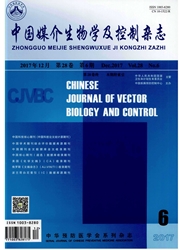

 中文摘要:
中文摘要:
目的了解深圳市坪山新区登革热传播媒介白纹伊蚊密度及二代成蚊携带登革热病毒情况,为登革热的防控提供科学的预警信息。方法 2016年4-8月对坪山新区不同生境的白纹伊蚊密度进行监测,白纹伊蚊专项监测采用诱蚊诱卵器法,蚊幼虫密度监测采用布雷图指数(BI)法,将采集的蚊幼虫和蚊卵饲养至成蚊,提取其核酸,利用实时荧光RT-PCR检测登革热病毒。结果 2016年4-8月白纹伊蚊平均诱蚊诱卵指数(MOI)为6.19;公园MOI(7.91)和BI(10.68)最高;8月MOI(10.28)和BI(15.42)最高;共检测白纹伊蚊1 190只,未检出登革热病毒。结论深圳市坪山新区白纹伊蚊未检出登革热病毒,但该蚊广泛分布且密度高,存在因登革热输入性病例引发本地疫情暴发的风险,应加强监测与防控。
 英文摘要:
英文摘要:
Objective To provide scientific information for the prediction and control of dengue fever by investigating vector species density and dengue virus infection in the second generation Aedes albopictus in Pingshan district of Shenzhen city. Methods Surveillance on the density of adult Ae. albopictus and larvae in different habitats were conducted by utilizing the methods of mosquito oviposition trap and Breteau index methods from April to August in 2016. Both larvae and eggs were collected and reared to adults in our laboratory. Nucleic acid was extracted and dengue virus was identified with real-time reverse transcriptase polymerase chain reaction(RT-PCR). Results The average mosquito and oviposition positive index(MOI)was 6.19; the park had the highest MOI and Breteau index(BI) with 7.91 and 10.68 respectively among different habitats; while among different months,the highest MOI and BI were in August with 10.28 and 15.42 respectively. A total of 1 190 Ae. albopictus tected negative for dengue virus. Conclusion Dengue virus in Ae. albopictus in Pingshan district was not detected, however, transmitting vectors were widely distributed and the density was high. A risk of local outbreak of dengue fever can be immediate by imported cases. Surveillance, prevention and control of dengue fever should be strengthened.
 同期刊论文项目
同期刊论文项目
 同项目期刊论文
同项目期刊论文
 期刊信息
期刊信息
